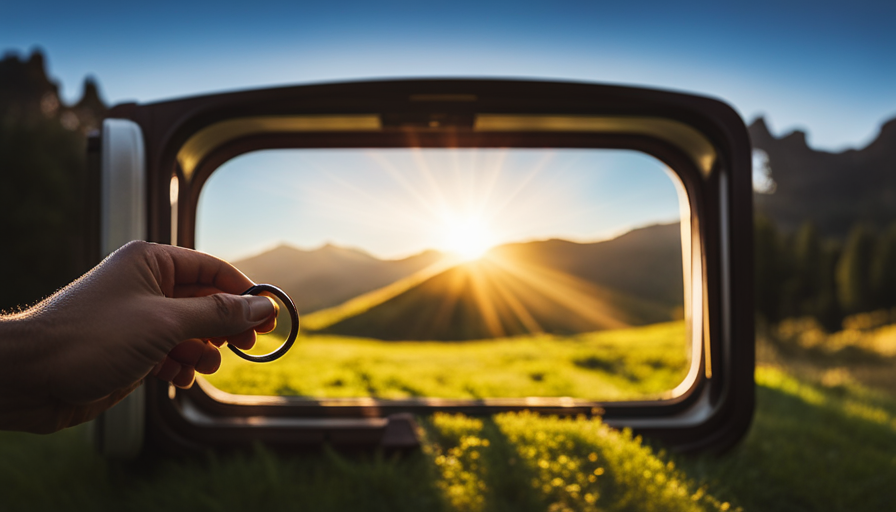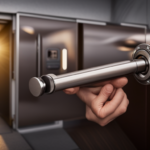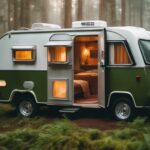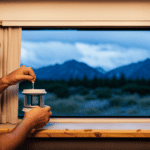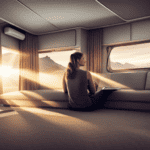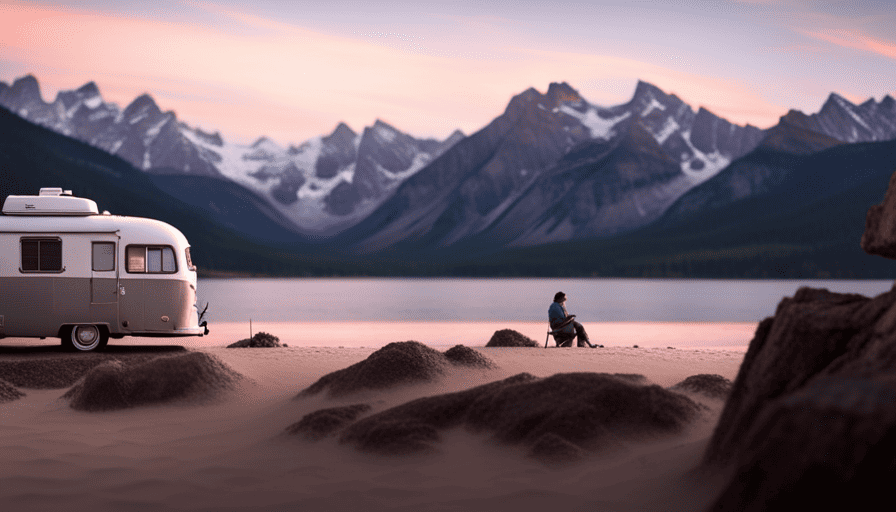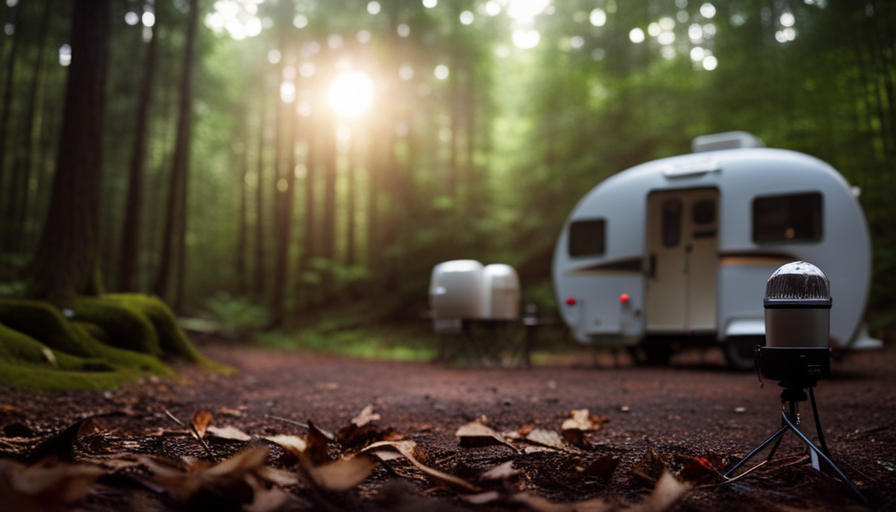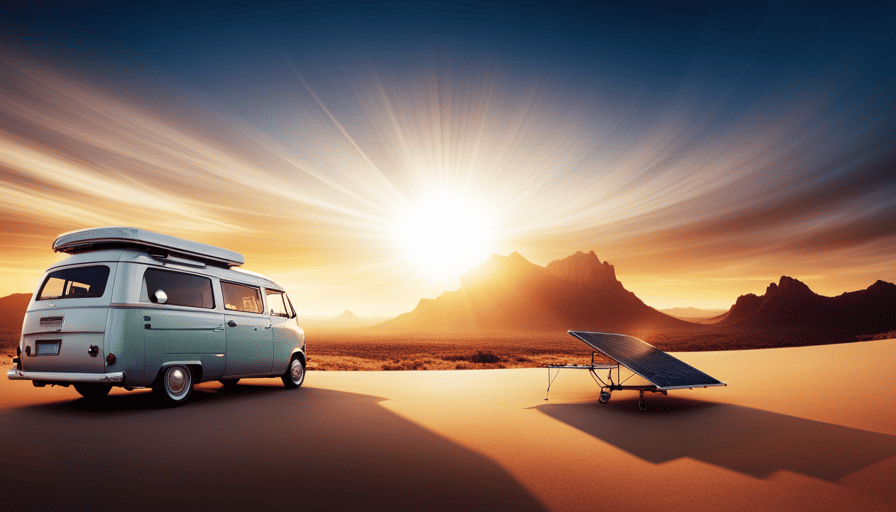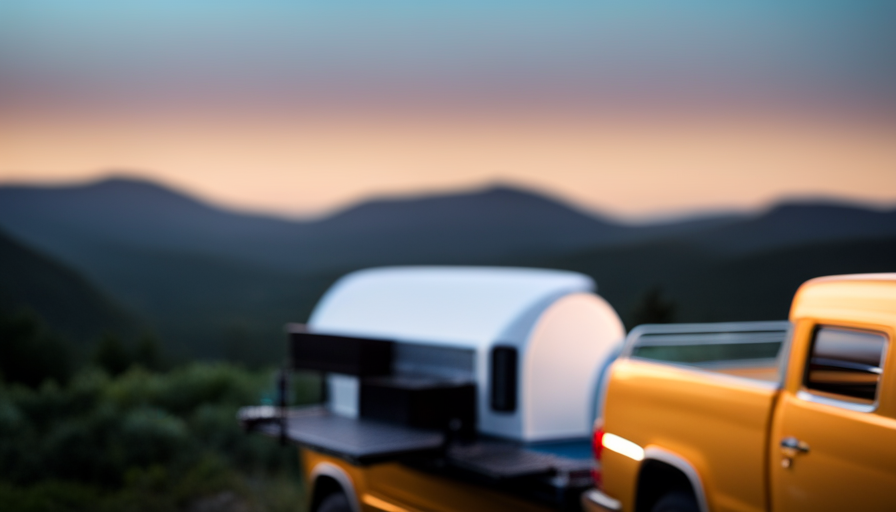Picture yourself on a camping adventure, relishing the clean air and stunning landscapes. However, all of a sudden, it becomes uncomfortably warm and stale inside your camper. What’s your next move? Cracking open the windows of your camper can usher in the essential airflow and establish a cozy environment to live in.
In this article, I will guide you through the process of opening camper windows step by step.
Understanding the window mechanism is crucial before attempting to open them. You need to check for safety locks and make sure the window tracks are clean. Using the window crank or lever, you can gradually apply pressure to open the windows. Additionally, considering window accessories like screens or blinds can enhance your camping experience.
To keep your camper windows in good working condition, regular maintenance and lubrication are essential. However, it’s important to be mindful of your surroundings and close and secure the windows when not in use to prevent any unwanted intrusions.
So, let’s dive into the details and learn how to open camper windows effectively and efficiently.
Key Takeaways
- Understanding the window mechanism is crucial before attempting to open camper windows.
- Check for safety locks and ensure window tracks are clean.
- Use the window crank or lever to gradually apply pressure and open the windows.
- Consider window accessories like screens or blinds for an enhanced camping experience.
Understand the Window Mechanism
To open your camper windows, you’ll need to understand how the window mechanism works and use it effectively to let in fresh air and natural light. Proper window maintenance is crucial to ensure smooth operation and prevent any issues that may arise.
When troubleshooting window issues, it’s important to first identify the type of window mechanism you have. Common types include slide windows, crank windows, and push-out windows.
Slide windows typically have a latch on the bottom that needs to be released before sliding the window open. Crank windows have a handle that needs to be turned clockwise to open and counterclockwise to close. Push-out windows require you to push a lever or button to release the window and then push it open manually.
Once you understand your window mechanism, you can proceed to check for safety locks or any other features that may need to be disengaged before opening the window.
Check for Safety Locks
First, make sure you’ve checked for any safety locks on your camper windows. It’s important to ensure that the windows are unlocked before attempting to open them. Here are some window safety measures to keep in mind:
-
Always check for window locks: Some camper windows come equipped with safety locks that prevent them from being opened accidentally. These locks may be located on the window itself or on the window frame. Make sure to locate and disengage any locks before trying to open the window.
-
Understand how the locks work: Familiarize yourself with the mechanism of the window locks. Some locks may require you to push or pull a lever, while others may have a button or switch that needs to be pressed or flipped. Knowing how the locks operate will help you unlock them more efficiently.
-
Consider using additional window safety measures: In addition to the built-in locks, you may also want to invest in additional window safety devices, such as window guards or window stops. These can provide an extra layer of protection to prevent accidental falls or intrusions.
-
Regularly inspect the window locks: It’s important to periodically inspect the window locks for any signs of wear or damage. Replace any faulty locks immediately to ensure the safety of your camper.
-
Teach others about window safety: If you’re traveling with children or guests, make sure to educate them about the importance of window safety and how to properly use the locks.
Now that we’ve covered window locks and safety measures, let’s move on to the next step: cleaning the window tracks.
Clean the Window Tracks
Now, it’s time to give those window tracks a thorough cleaning to ensure smooth gliding like a breeze through a meadow. Cleaning the window tracks is an important maintenance step that should not be overlooked. Over time, dirt, dust, and debris can accumulate in the tracks, causing the windows to stick or not open properly. To clean the window tracks, you will need a few simple tools: a vacuum cleaner with a brush attachment, a small brush or toothbrush, and some cleaning solutions.
To begin, use the vacuum cleaner to remove any loose dirt or debris from the tracks. Make sure to reach into the corners and crevices to get rid of all the dirt. Next, take your small brush or toothbrush and dip it into a cleaning solution of your choice. Gently scrub the tracks, paying special attention to any stubborn dirt or grime. Rinse the brush frequently to ensure effective cleaning. Finally, use a damp cloth or sponge to wipe away any remaining cleaning solution and dirt.
By regularly cleaning the window tracks, you can ensure that your camper windows open and close smoothly. Once the tracks are clean, you can move on to the next step: using the window crank or lever to open the windows.
Use the Window Crank or Lever
Once the tracks are clean, simply grab hold of the window crank or lever and effortlessly glide the windows open, allowing the fresh air to fill your cozy camper. Understanding the different types of camper windows can help troubleshoot any issues that may arise.
There are two common types of camper windows: crank-out windows and sliding windows. Crank-out windows have a handle that you turn to open or close the window, while sliding windows have a lever that you push or pull to slide the window open or closed.
To open a crank-out window, locate the window crank and turn it clockwise until the window starts to open. If the window is difficult to open, try applying a small amount of lubricant to the crank mechanism.
For sliding windows, locate the lever and push or pull it in the direction you want the window to move. If the window is stuck, check for any debris or obstructions in the window track and remove them before attempting to open the window.
Remember to apply pressure gradually when opening the windows to avoid any damage or accidents. By following these steps, you can easily open your camper windows and enjoy the fresh air while on your adventures.
Apply Pressure Gradually
When dealing with stubborn camper windows, it’s crucial to apply gentle pressure in order to open them. Using excessive force can lead to potential damage to the window mechanism or even break the glass. By gradually increasing the pressure, you can ensure a smooth and safe opening. This allows you to enjoy fresh air and natural light inside your camper without any unnecessary risks.
Apply gentle pressure to open stubborn windows
To make opening stubborn camper windows easier, simply apply gentle pressure and let the fresh air flow in, like a gentle breeze through a field of wildflowers. When it comes to window maintenance, it’s important to troubleshoot any issues that may arise. Sometimes, windows can become stuck or difficult to open due to dirt, debris, or a lack of lubrication. In these cases, applying gentle pressure can help loosen the window and make it easier to open. However, it’s crucial to avoid using excessive force to prevent damage. Remember, a little patience goes a long way when it comes to opening stubborn windows. By applying gentle pressure and taking the time to troubleshoot any issues, you can ensure a smooth and enjoyable camping experience.
Avoid using excessive force to prevent damage
Be mindful of the potential for damage by refraining from applying excessive force when trying to open stubborn windows in your camper. It’s important to prevent window breakage and preserve window longevity.
Applying excessive force can lead to cracked or shattered windows, which can be costly to replace. Instead, try using a gentle and steady pressure when attempting to open stubborn windows. If the window doesn’t budge, it may be helpful to use a silicone-based lubricant to loosen any stuck components.
Additionally, check for any debris or obstructions that may be preventing the window from opening smoothly. By taking these precautions, you can avoid unnecessary damage and ensure the longevity of your camper windows.
Now, let’s move on to the next section about using window screens for ventilation.
Use Window Screens for Ventilation
Using window screens in your camper is a great way to let fresh air in while keeping bugs out. Window screens are designed to fit perfectly in the window frame, allowing air to flow through while blocking insects from entering your living space.
These screens are made from a durable mesh material that’s resistant to tears and can withstand the elements. One of the main advantages of using window screens is their ability to provide ventilation while still providing shade.
The mesh material allows air to circulate freely, creating a cool and comfortable environment inside your camper. This is especially beneficial during hot summer days when you want to enjoy the fresh air without being exposed to direct sunlight.
In addition to providing ventilation and shade, window screens also act as a barrier against bugs. The fine mesh prevents mosquitoes, flies, and other insects from entering your camper, ensuring a bug-free living space.
This is particularly important if you’re camping in areas with a high bug population or near bodies of water. Consider window accessories such as awnings or blinds to further enhance the functionality of your camper windows.
These accessories can provide additional shade and privacy while still allowing for ventilation. By utilizing window screens and accessories, you can create a comfortable and bug-free living environment in your camper.
Consider Window Accessories
Enhance the functionality of your camper’s view with window accessories that act as the perfect sunglasses, providing shade and privacy while still allowing the breeze to dance through.
There are various window accessories available in the market that can enhance your camper’s ventilation options. Here are five items that can make your camping experience more enjoyable:
-
Window tinting: Apply tint film to your camper windows to reduce glare, block harmful UV rays, and keep the interior cool.
-
Window awnings: Install retractable awnings above your windows to provide shade and protection from rain, allowing you to keep the windows open even during light showers.
-
Window deflectors: Attach window deflectors to the top of your windows to create a small gap that allows fresh air to enter while preventing rain from getting in.
-
Window screens: Fit window screens to keep bugs and insects out while still allowing air to circulate freely.
-
Ventilation fans: Install roof or wall-mounted ventilation fans to exhaust stale air and draw fresh air into your camper.
These window accessories not only provide additional ventilation options but also enhance your privacy and comfort during camping trips.
Now, let’s move on to maintaining and lubricating the window mechanisms to ensure smooth operation.
Maintain and Lubricate Window Mechanisms
To keep your camper’s window mechanisms running smoothly, make sure to regularly maintain and lubricate them. Lubricating the mechanisms is crucial to prevent rust, corrosion, and sticking. It also ensures that the windows can be easily opened and closed, providing proper ventilation inside the camper.
When it comes to maintaining and lubricating window mechanisms, there are a few important steps to follow. First, inspect the mechanisms for any signs of wear or damage. If you notice any issues, such as broken or bent parts, they may need to be repaired or replaced.
Next, clean the mechanisms using a mild detergent and water. Be sure to remove any dirt, debris, or buildup that may be hindering the smooth operation of the windows. After cleaning, dry the mechanisms thoroughly to prevent moisture-related issues.
Once the mechanisms are clean, apply a lubricant specifically designed for window mechanisms. This will help reduce friction and ensure smooth movement. Be sure to follow the manufacturer’s instructions for application and use only a small amount of lubricant.
Troubleshooting common issues with window mechanisms includes checking for loose screws or bolts, adjusting the tension of the springs if necessary, and ensuring that the tracks are clean and free from obstructions.
By regularly maintaining and lubricating your camper’s window mechanisms, you can enjoy hassle-free operation and extend their lifespan. With the mechanisms in good condition, you can now move on to the next section about being mindful of your surroundings when opening the windows.
Be Mindful of Surroundings
Watch out for potential hazards around you as you enjoy the fresh air and natural light streaming into your cozy home on wheels. When opening camper windows, it’s important to be mindful of your surroundings and prioritize outdoor camping safety to prevent accidents.
Before opening the windows, take a moment to assess the area outside your camper. Look for any low-hanging branches, sharp objects, or uneven terrain that may pose a risk. Clear away any obstacles that may obstruct the window’s path or potentially cause damage. Additionally, be cautious of any nearby campfires or barbecues that could lead to fire hazards.
By being aware of your surroundings, you can ensure a safe and enjoyable camping experience. Remember to close and secure windows when not in use to prevent unwanted entry of insects, animals, or debris. This’ll also help maintain the integrity of your camper’s interior by keeping out moisture and dust.
Prioritizing safety and taking preventative measures will allow you to fully enjoy the benefits of fresh air and natural light while minimizing any potential risks.
Close and Secure Windows When Not in Use
When I’m leaving the camper, I always make sure to close and lock all the windows to ensure the safety and security of my belongings.
It’s important to double-check that all the windows are properly secured to prevent any potential damage or theft while I’m away.
By following this practice, I can have peace of mind knowing that my camper is protected and secure.
Close and lock windows when leaving the camper
Make sure you close and lock all the windows before you leave the camper. It’s essential for window maintenance and to ensure the safety and security of your belongings inside.
Here are some benefits of window screens to consider:
-
Keeps out insects and pests: Window screens act as a barrier, preventing bugs and other unwanted creatures from entering the camper.
-
Allows fresh air circulation: With window screens, you can enjoy a cool breeze while keeping the windows closed, maintaining privacy and security.
-
Filters out dust and debris: Window screens help to keep your camper’s interior clean by trapping dust and debris before they enter.
-
Provides UV protection: Window screens block harmful UV rays from entering the camper, protecting your furniture and belongings from fading or damage.
-
Enhances privacy: Window screens offer an additional layer of privacy, allowing you to enjoy your time inside the camper without worrying about prying eyes.
To ensure all windows are properly secured to prevent damage or theft, make sure to follow these guidelines.
Ensure all windows are properly secured to prevent damage or theft
When it comes to camper windows, it’s crucial to ensure they’re properly secured to prevent any potential damage or theft.
As a camper owner, I understand the importance of window maintenance and taking proactive measures to prevent window condensation. By regularly inspecting and cleaning the windows, I can ensure they’re in good condition and free from any debris or dirt that may hinder their functionality.
Additionally, I make sure to check the window seals and frames for any signs of wear or damage, as this can lead to condensation buildup. To prevent window condensation, I utilize ventilation techniques such as cracking open a window slightly or using a dehumidifier inside the camper.
By following these steps, I can maintain the integrity of my camper windows and prevent any potential issues in the future.
Frequently Asked Questions
Can I use any type of lubricant on the window mechanism?
Sure, you can use any type of lubricant on the window mechanism, as long as you want your camper windows to be a slippery mess. I mean, who needs proper window ventilation when you can have windows that slide open like a greased pig?
But if you actually want to do it right, I recommend using a silicone-based lubricant that won’t attract dirt and grime, ensuring smooth operation and longevity of your camper windows.
What are some common mistakes to avoid when opening camper windows?
To avoid common mistakes when opening camper windows, it’s important to use the proper technique. One mistake to avoid is forcing the window open or closed, as this can damage the window mechanism. Instead, use gentle and steady pressure to open or close the window.
Another mistake is neglecting to clean and lubricate the window mechanism regularly, which can cause it to become stiff and difficult to operate.
By following these guidelines, you can ensure smooth and hassle-free window operation in your camper.
Are there any additional safety features I should consider for my camper windows?
When it comes to window maintenance and camper window security, there are several additional safety features to consider. Firstly, installing window locks can provide an extra layer of security, preventing unwanted access to your camper.
Additionally, using window screens can help keep insects out while still allowing fresh air in.
Lastly, considering the material of your camper windows, such as tempered glass, can enhance their durability and resistance to breakage.
How often should I clean and maintain the window tracks?
Cleaning and maintaining window tracks in campers is crucial to ensure optimal functionality. According to a recent study, neglecting this task can lead to a 30% decrease in window performance over time.
To maintain the window tracks, it’s recommended to clean them at least once every three months. Start by removing any debris using a soft brush or vacuum, then wipe the tracks with a mild detergent and water solution.
Regular cleaning and adherence to these best practices will extend the lifespan of your camper windows.
Can I install window screens on all types of camper windows?
Yes, you can install window screens on all types of camper windows. When it comes to window screen installation tips, it’s important to choose the right screens for your camper. Look for screens that are specifically designed for camper windows and ensure they’re the correct size. Measure the dimensions of your windows accurately before purchasing.
Additionally, consider screens with adjustable frames or magnetic attachments for easy installation and removal.
Conclusion
In conclusion, opening camper windows is a simple yet important task for ensuring proper ventilation and comfort while on the road. By understanding the window mechanism, checking for safety locks, and using the window crank or lever, you can easily let fresh air in.
Remember to clean the window tracks, maintain and lubricate the mechanisms, and be mindful of your surroundings. Just like a breath of fresh air rejuvenates the body, opening camper windows rejuvenates the spirit of your journey, allowing you to fully embrace the adventure ahead.

